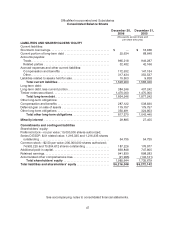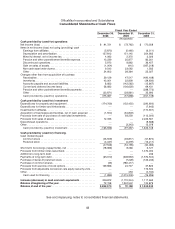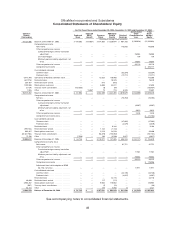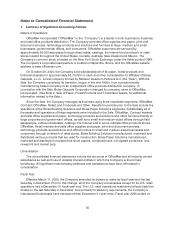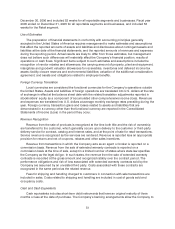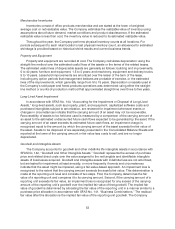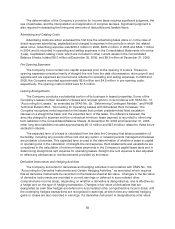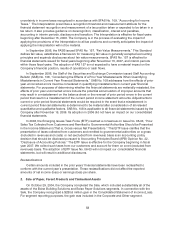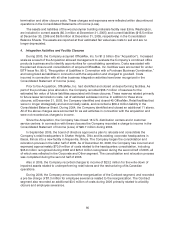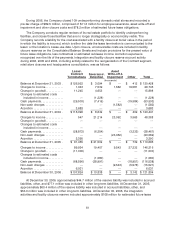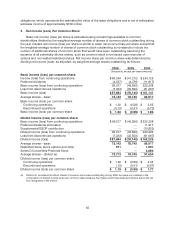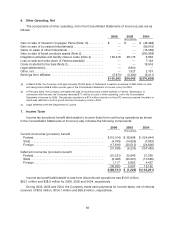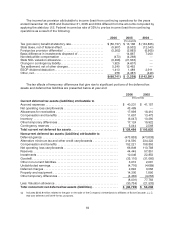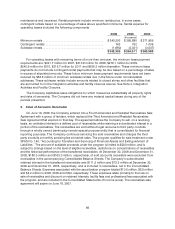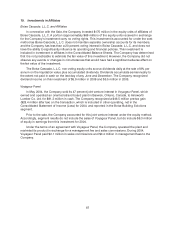OfficeMax 2006 Annual Report Download - page 61
Download and view the complete annual report
Please find page 61 of the 2006 OfficeMax annual report below. You can navigate through the pages in the report by either clicking on the pages listed below, or by using the keyword search tool below to find specific information within the annual report.57
hedge, changes in the fair value of the instrument are reported in current earnings and offset the
change in fair value ofthe hedged assets, liabilities or firmcommitments. The ineffective portion of an
instrument’s change infair value is immediately recognized in earnings. Instruments that do not meet
the criteria for hedge accounting or contracts for which the Company has not elected hedge
accounting, are marked to fair value with unrealized gains or lossesreported in earnings.
Recently Issued or Newly Adopted AccountingStandards
Following are summaries of recentlyissued accounting pronouncements that have either been
recently adopted or that may become applicable to the preparation of the Company’s consolidated
financial statements in the future.
In December 2004, the Financial Accounting Standards Board (“FASB”)issuedSFAS No. 123R,
“Share Based Payment.” SFASNo. 123R is a revision of SFAS No. 123, “Accounting forStock-Based
Compensation,” and supersedes Accounting Principles Board Opinion (APB) No. 25, “Accounting for
Stock Issued to Employees,” and its related implementation guidance. SFAS No. 123Rfocuses
primarily on accountingfor transactions in which anentity obtains employee services in exchange for
share-based payments. SFAS No. 123R requires entities torecognize compensation expense from all
share-based paymenttransactions in the financial statements.SFAS No. 123R establishes fair value
as the measurement objective in accounting for share-based payment transactions and requires all
companies to apply a fair-value-based measurement method in accountingfor share-based payment
transactions with employees.
Effective January 1, 2006, the Company adopted SFASNo. 123R usingthe modified prospective
transition method. Accordingly, the financial statements for periods prior to January 1, 2006 havenot
been restated to reflect the adoption of SFAS No. 123R.Under the modified prospective transition
method, the Company must record compensation expense for all awards granted after the adoption
date and for the unvested portion of previously granted awards that remain outstanding at the
adoption date, under the fair value method.Previously, the Company recognized compensation
expensefor share-based awards to employees using the fair-value-based guidance in SFAS No. 123.
Due to the fact that theCompany had previouslyaccounted for share-based awards using
SFAS No. 123, the adoption of SFAS No. 123R did not have a material impact on the Company’s
financial position, results of operations or cash flows.
During 2006, the Company adopted SFAS No. 158, “Employer’s Accounting for DefinedPension
and Other Postretirement Plans—an amendment of FASB Statements No. 87, 88, 106 and 132(R).”
This Standard requires that employersrecognize, on a prospective basis, thefunded status of their
defined benefit and postretirement benefit plans in the statement of financial position, and that
changes in the funded status be recognized as acomponent of other comprehensive income, net of
tax. SFAS No. 158 also requires the funded status of a plan to be measured as of the date of the year-
end statement of financial position, and requires additional note disclosures. Therecognition and
disclosure guidance in SFAS No. 158 is effective as ofthe end of the first fiscal year ending after
December 15, 2006, and other measurement elements are effective for fiscal years ending after
December 15, 2008. The Company adopted the recognition provisions of SFAS No. 158 andinitially
applied themto the funded status ofits defined benefit pension and other postretirement benefit plans
as of December 31, 2006. The initial recognition of the funded status of our defined benefit pension
and other postretirement plans resulted in an increase inShareholders’ Equity of $11.9 million, which
wasnet of income taxes of $7.6 million. We currently measure the funded status of ourdefined benefit
plans as of the date of our fiscal year-end statement of financial position, and therefore, the adoption
of themeasurement provisions of SFAS No. 158 willhave no impact onour financial statements.
In June 2006, the FASB issued Interpretation (FIN) No. 48, “Accounting for Uncertainty in Income
Taxes– an interpretation of FASB Statement No. 109.”This Interpretation clarifies the accounting for


